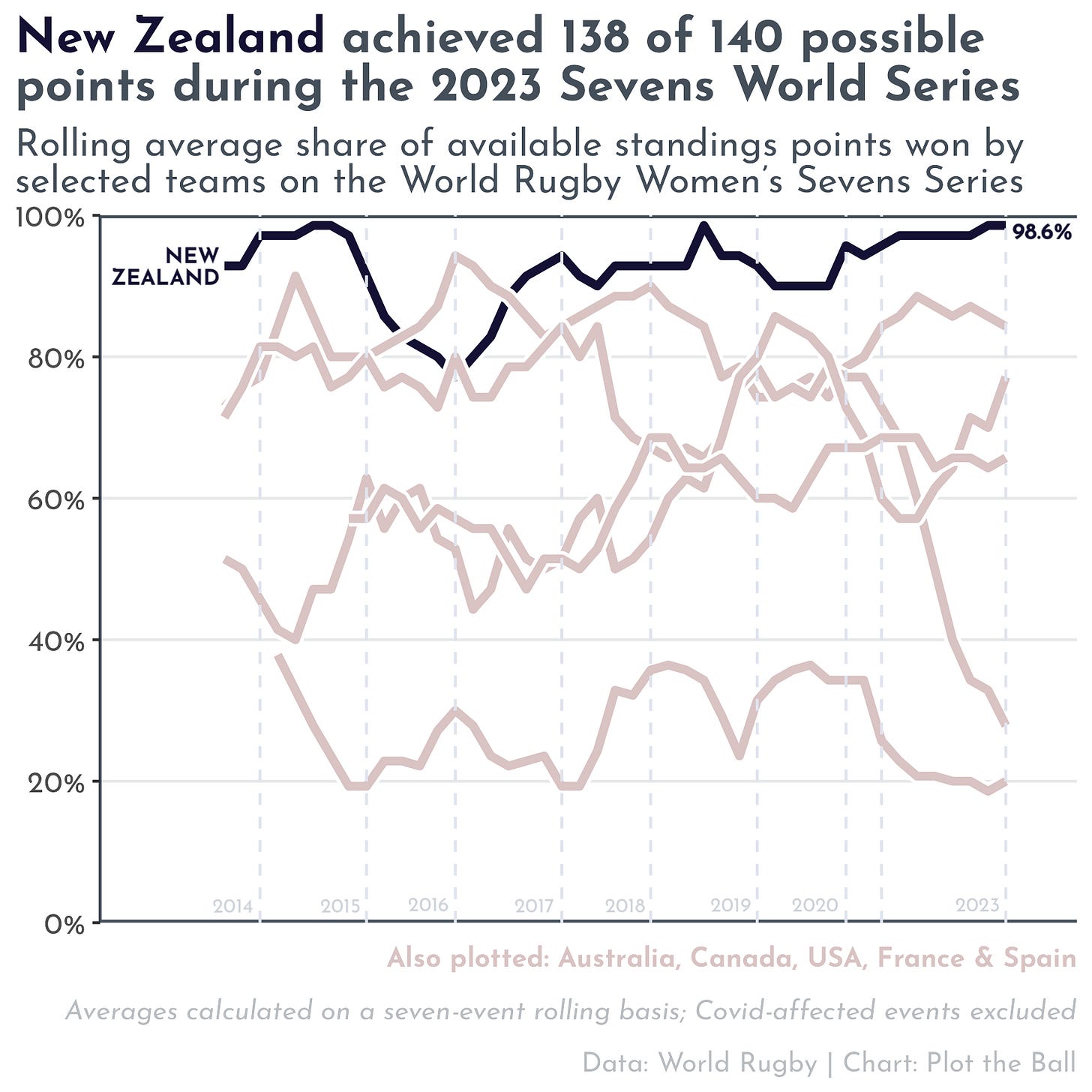🏉 The Black Ferns Sevens are as good as they've ever been. What comes next?
Small ball
Welcome to the 11th edition of Plot the Ball for 2023.
Rugby sevens tends to receive little media and audience attention — even by the standards of the sheltered corner of the sporting world in which it is situated — but is an excellent place to watched incredibly fit, highly skilled athletes combine and compete in wide open spaces. This is particularly true in the women’s game, which benefited from concerted financial investment (as well as an influx of talent from other codes) in many countries ahead of its introduction into the Olympics in 2016. New Zealand won gold in Rio in 2021, and have just secured another World Rugby Women’s Sevens Series title — but the broader professionalisation of women’s rugby may well have an impact on their future.
The Black Ferns Sevens are as good as they've ever been. What comes next?
14 minutes isn’t a very long time in sport.
That, for reference, is how long a game of rugby sevens lasts1.
In general, shorter sporting contests lead to greater variability of outcomes; over longer stretches of action, results stabilise as skill plays a greater role and luck plays a lesser role.
And this principle makes the continuing dominance by New Zealand of women’s sevens all the more remarkable.
In the recently concluded 2022-23 World Rugby Women’s Sevens Series they won six of the seven scheduled events — each of which culminates in a single-elimination knockout stage — outright.
By coming second in the other — after losing the final — the Black Ferns Sevens team claimed 138 of the 140 standings points available to them over the course of the season.
This run of form — taking 99% of possible points — equalled2 their best-ever seven-event stretch since the inception of the Series in 2012.
Based on these numbers, New Zealand are as good as they’ve ever been — but the world of women’s sport is changing around them.
For a long time, the Black Ferns Sevens program was the only professional gig in town3 for aspiring Kiwi rugby players; but other options now exist within New Zealand’s borders — and beyond.
Alongside the full-time professional contracts introduced for the nation’s 15-a-side rugby union team in 2022, the NRLW — a rugby league competition in Australia, a much larger and more economically powerful market than New Zealand — has emerged as a competitor for talent.
And those in charge of the sport have acknowledged as much publicly in recent times. After announcing the release of a player from their Black Ferns Sevens contract to play in the NRLW earlier this week, New Zealand Rugby’s General Manager in charge of Professional Rugby & Performance said:
Looking at the composition of this year’s title-winning Black Ferns Sevens team, this changing landscape may already be having an effect.
If you compare the 2022-23 side to the squad which won the 2018-19 series — the last completed season pre-Covid — it becomes clear that transitioning from one generation of players to the next has not been a smooth process.
In both 2018-19 and 2022-23, peak-age4 players — defined here as those between the ages of 23 and 29 years old —made a similar share of appearances: 62% in the former season, and 64% in the latter.
But beyond the core of the squad, the distribution of playing time has changed drastically.
In 2018-19, ‘pre-peak’ players5 made 24% of all appearances, with ‘post-peak’ players6 contributing the remaining 14%.
However, this split had basically inverted by 2022-23: ‘post-peak’ players made 22% of the team’s appearances, and ‘pre-peak’ players made only 14%7.
The 10 years which have passed since the first edition of the Women’s Sevens Series concluded isn’t a very long time in the wider arc of top-level sport either — and this is especially the case on the women’s side, where professional systems are generally yet to bed in as fully.
The Black Ferns remain on top of the world of sevens for now — but more and better opportunities to play sport for a living for the pool of athletes they select from mean that it’s not a foregone conclusion that this dominance will continue.
You can find the code for this piece on GitHub here
For the uninitiated, a game of fifteen-a-side rugby union lasts 80 minutes.
They hit the same return on a seven-event rolling basis midway through the 2014-15 Series, and midway through the 2018-19 series.
To simplify things, this classification has been done by year of birth: ‘peak-age’ players for 2018-19 were those born from 1990 and 1996, and for 2022-23 were those born between 1994 and 2000.
Those younger than 23 years old.
Those older than 29 years old.
They have unearthed a star in the form of 19-year-old Rookie of the Year Jorja Miller — and she seems intent on sticking with her preferred format for the time being.



